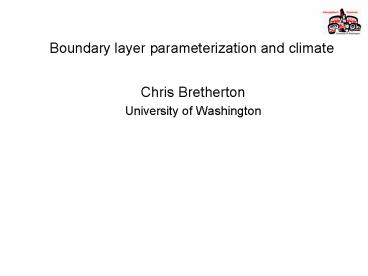Boundary layer parameterization and climate - PowerPoint PPT Presentation
Title:
Boundary layer parameterization and climate
Description:
PBL cloud feedbacks on tropical circulations, climate sensitivity and aerosol ... Diurnal cycle biases (Yang and Slingo 2001) UKMO Unified Model. Satellite ... – PowerPoint PPT presentation
Number of Views:24
Avg rating:3.0/5.0
Title: Boundary layer parameterization and climate
1
Boundary layer parameterization and climate
- Chris Bretherton
- University of Washington
2
Some PBL-related climate modeling issues
- PBL cloud feedbacks on tropical circulations,
climate sensitivity and aerosol indirect effect
in all latitudes. - Wintertime land surface temperature biases
- stable boundary layer
- cloud biases
- role of land surface vs. PBL
- PBL interactions with deep convection
- gustiness, enhanced surface flux over warm oceans
- cumulus cloud base properties
- diurnal cycle over land
- Surface wind stress
- ocean (warm pool, coasts, cold side of ocean
fronts) - complex terrain
- Optimal resolution tradeoff Dz and Dt vs. Dx-Dy.
3
PBL params improving (with large-scale
feedbacks) biases remain.
EPIC2001 ECMWF NCEP AM2.10 CAM2.0
Bretherton et al. (2004)
Yu and Mechoso (2001)
4
PBL cloud feedbacks on climate sensitivity
- Is every geographical region different?
- Lack of published physical mechanisms
- (-) In warmer climate, adiabatic dLWC/dz larger,
so PBL clouds of given thickness are more
reflective (Somerville and Remer 1984). - but not much evidence for such trends with T.
Tselioudis and Rossow (1994)
5
- (-) In warmer climate, steeper moist adiabat
raises lower tropospheric stability, increasing
low cloud cover (Miller 1997 based on Klein and
Hartmann 1993). - but how to apply Klein line to changed
climate (or even its robustness in current
climate) is questionable.
- Observed TOA net CRF moderately correlated to
LTS. - In CAM3, LTS increases 2 K in 2xCO2 climate with
little NCRF change.
6
Alternative LTS measures more climate-stable?
- Estimated Inversion Strength (Rob Wood)
- EIS LTS - (z700-LCL)(dq/dz)moistad(700 mb)
700
LCL
1000
LTS q700 q1000
EIS qLCL,ma q1000
(Klein and Hartmann 1993)
- Collapses midlatitude vs. low-lat. Sc regimes
better. - EIS less sensitive than LTS to steeper moist
adiabat Þ predicts less low cloud feedback on
climate sensitivity.
7
Anthropogenic aerosol-CTBL feedbacks
- Major IPCC uncertainty (current DFTOA 0-2 W
m-2). - CTBLs likely a major contributor.
- Manifest in POCs (pockets of open cells Stevens
et al. 2005)? - Limited understanding of aerosol feedbacks on PBL
cloud thickness, lifetime thru drizzle, radiative
feedbacks.
POCs
Bretherton et al (2004)
8
POCS, cloud droplet size, and drizzle
Rob Wood Sandy Yuter
9
DYCOMS RF02 nocturnal drizzling stratocumulus
Nd 45-70 cm-3
(Stevens et al. 2003 vanZanten et al. 2005)
10
GCSS RF02 SCM/LES intercomparison
LES
Extremely diverse dependence of Sc drizzle on LWP
11
High-latitude wintertime PBL
- AGCMs often have large high-latitude surface
temperature biases. These can feed back on
snow-albedo feedback and biogeochemistry.
CAM3 DJF T2m bias
Low cloud bias
12
- Inadequate attention has been paid to
understanding the role of stable BL turbulence
vs. clouds vs. land-surface in these biases. - Often addressed by large-Ri tuning of stability
functions, which may compensate other errors. - NWP-mode testing of climate models would help!
- Sensitive to underresolution of PBL depth
terrain.
Enhanced hi-Ri mixing
M-Y stability fns
13
PBL interactions with deep convection
- The PBL under precipitating deep convection is
highly inhomogeneous, enhancing surface fluxes
and complicating Cu parameterization.
Kuang and Bretherton (2005)
14
Cu base properties
Cold pool tail
(Kuang and Bretherton 2005)
- Narrow range (0.1K, 0.3 g kg-1) of cloudy
updraft properties - Moist (but not most buoyant) tail of PBL air
forms Cu bases. - Cold pools affect near-surface (but not upper
PBL) air properties. - Suggests prediction of PBL T/q PDF would help Cu
parameterization.
15
Diurnal cycle biases (Yang and Slingo 2001)
Satellite
UKMO Unified Model
Local time of peak precipitation
- Satellite shows early evening peak over land,
early morning peak over ocean ITCZ. - Models show late morning peak over land, midnight
peak over ocean. - Mainly Cu param, but maybe also PBL
parameterization issue?
16
Wind stress in EPIC2001 95W cross-equatorial flow
Raymond et al. (2004)
aircraft obs.
NCEP GDAS
Observed dty/dy absent
Shear in SBL
Surface jet in CBL
GCM resolution badly smears wind stress gradients
17
PBL wind stress errors II
- Momentum transport problems in stable
warm-advection PBLs (Brown et al. 2005).
ug EC ctrl M-O stab sonde
18
Resolution
- Vertical resolution is a concern for both stable
and cloud-topped boundary layers. - In GCMs, we typically screw up our climate when
changing vertical resolution. The role of PBL
processes in this is hard to disentangle, but
likely significant. - More GABLS/GCSS-style benchmark LES/SCM/regional
model simulations (including katabatic flows over
undulating terrain) are needed for us to better
appreciate our discretization errors.
19
Some perspectives on these problems
- In the U.S. we have great field expts and data,
but almost no full-time PBL parameterization
developers and closely connected to major GCMs.
This is a social crisis. - Broad PBL issues (e. g. high latitude low
cloud/land temperature biases) are going almost
unstudied in the U.S. climate community.
Cross-talk with NWP models and NWP-mode
simulations are valuable strategies. - These biases assume increasing importance as we
couple more systems (e.g. plants, ice) into our
models. - We often explore horizontal resolution, but we
must also routinely push GCMs to much higher
vertical and time resolution to understand how
well converged their PBL climatology is, even if
we are afraid of the answers.































